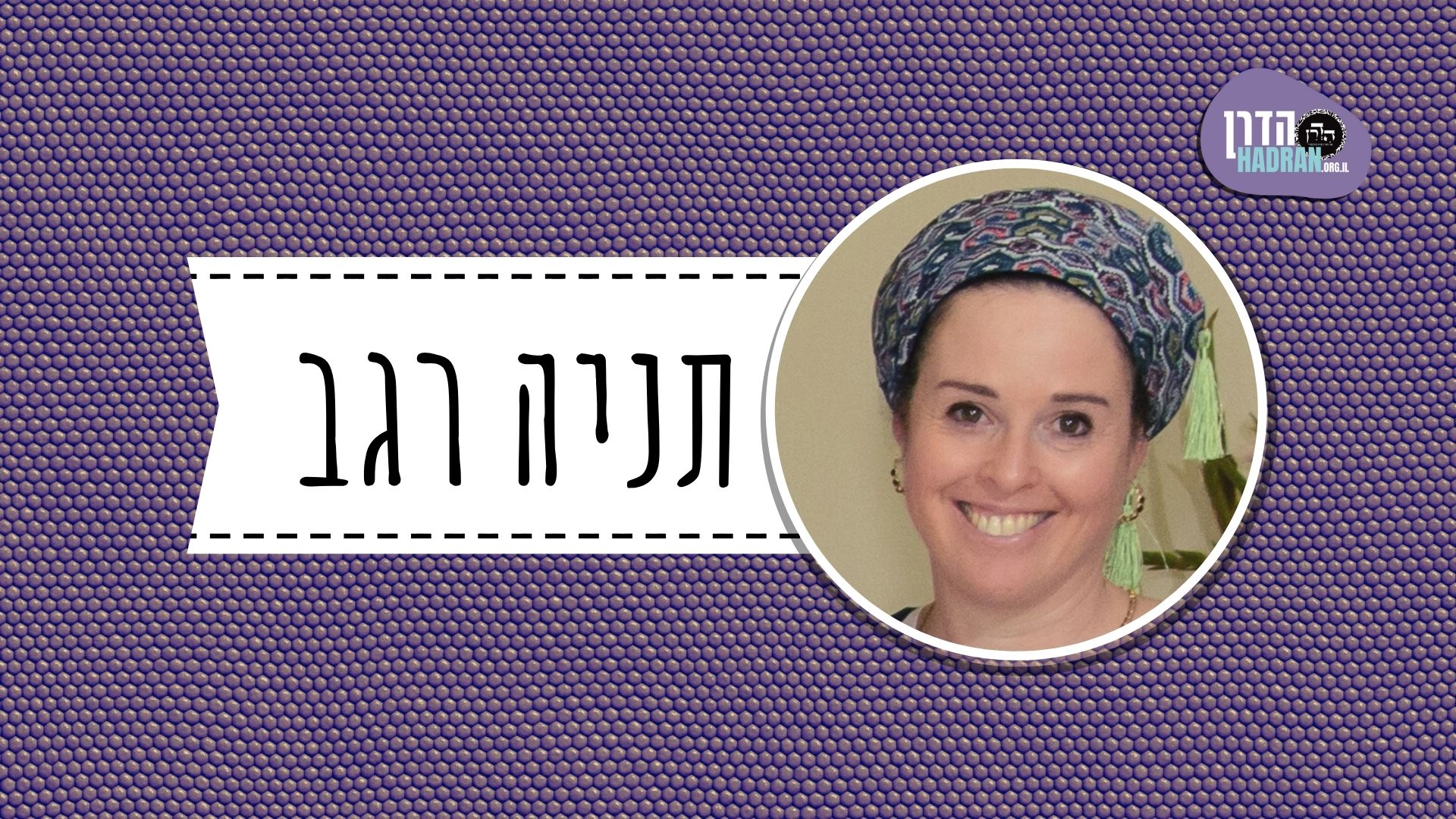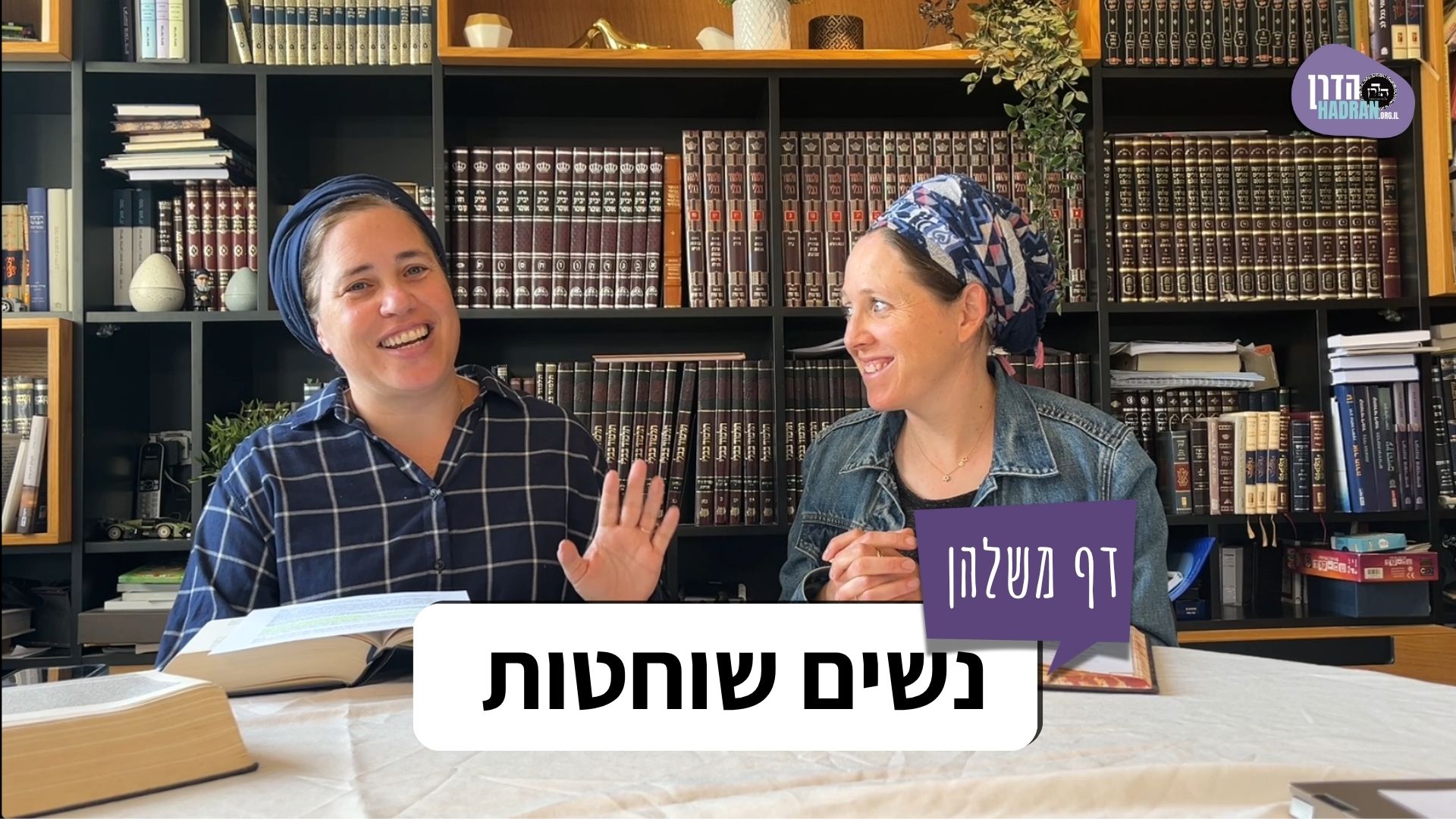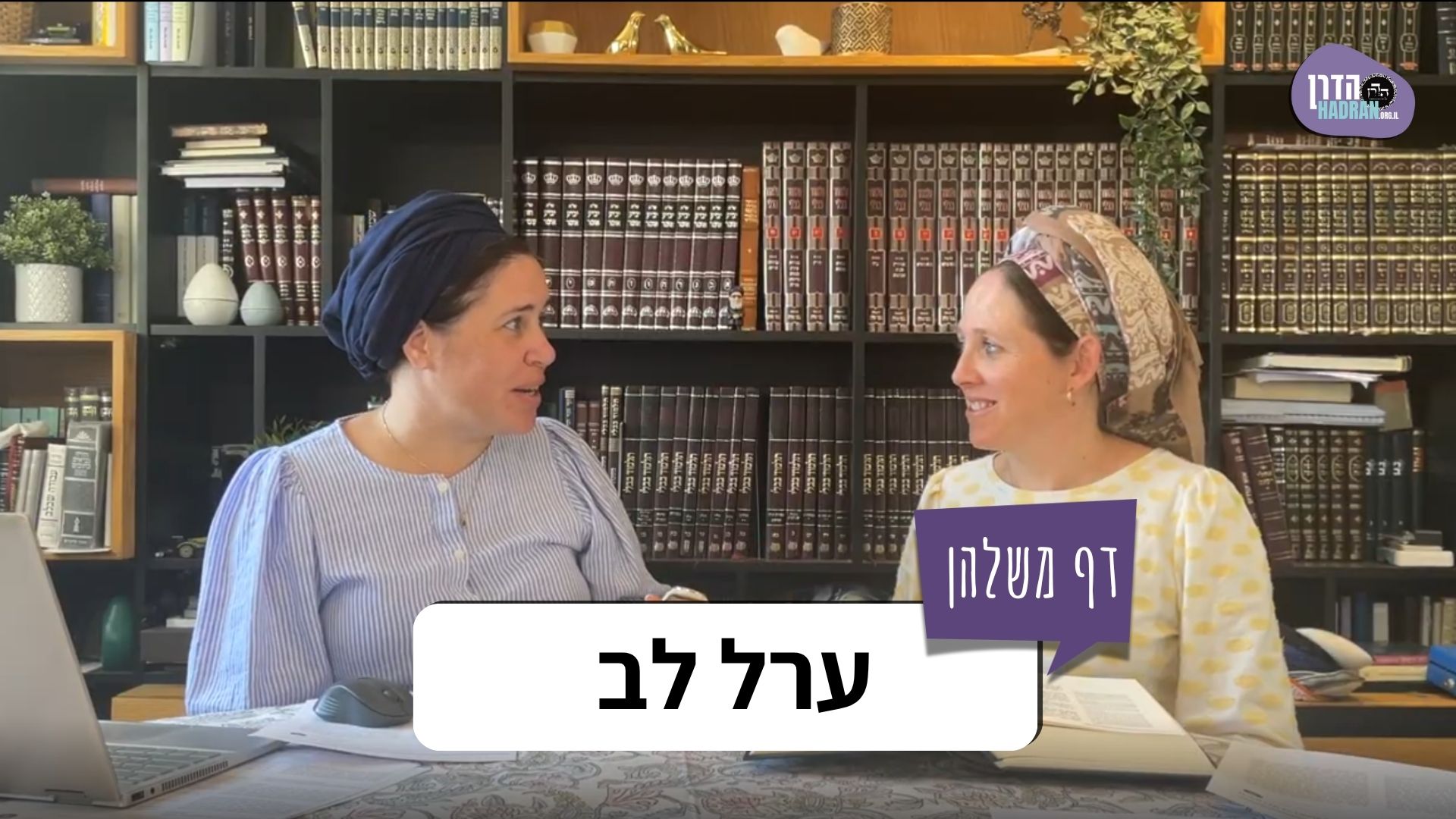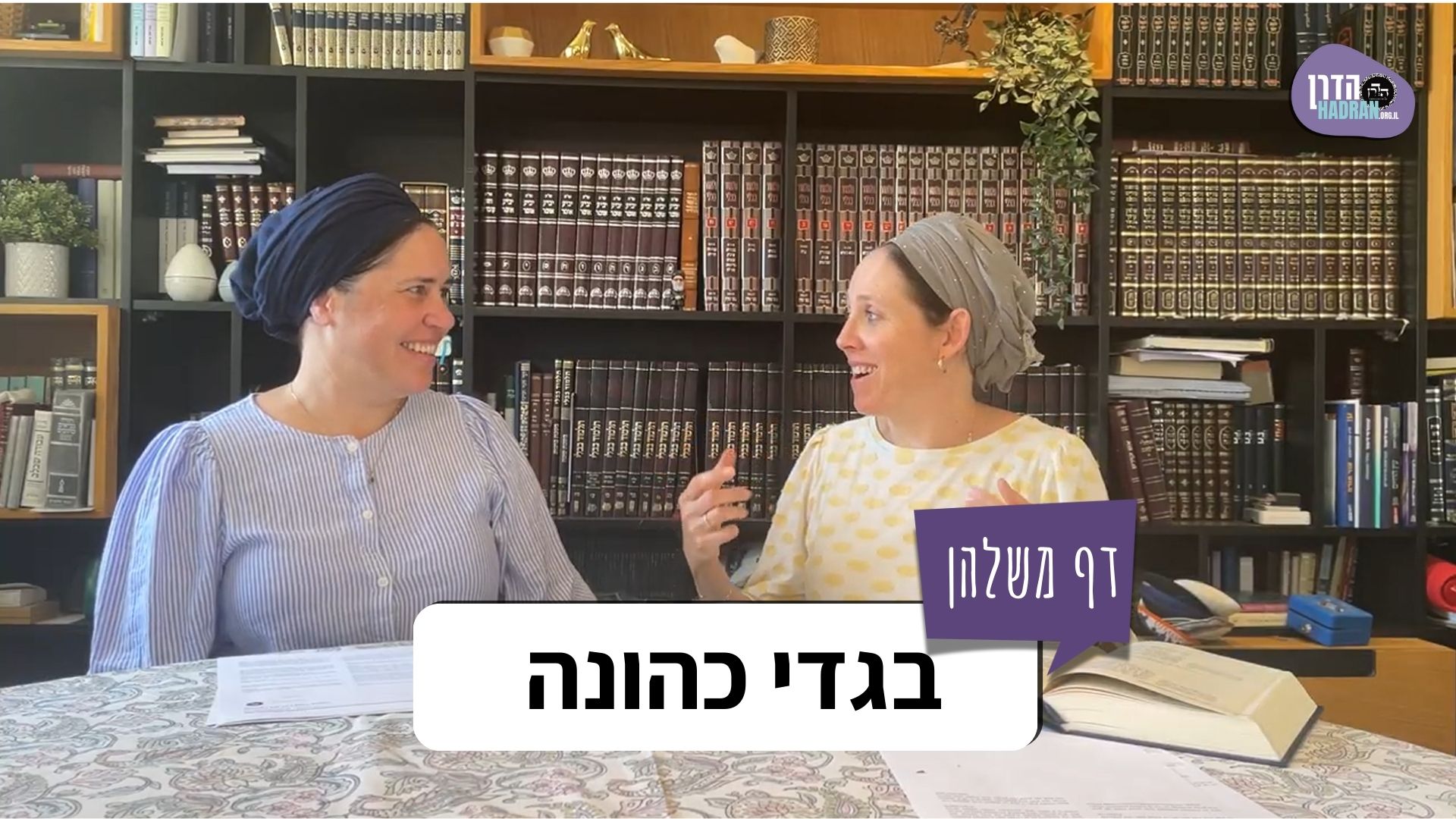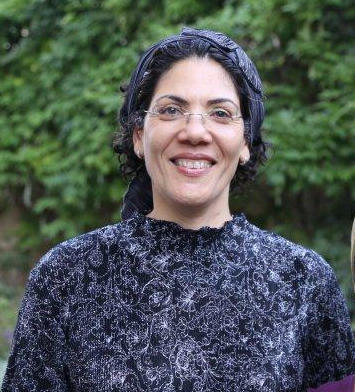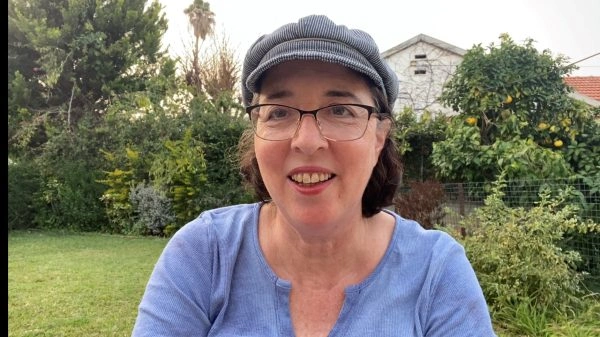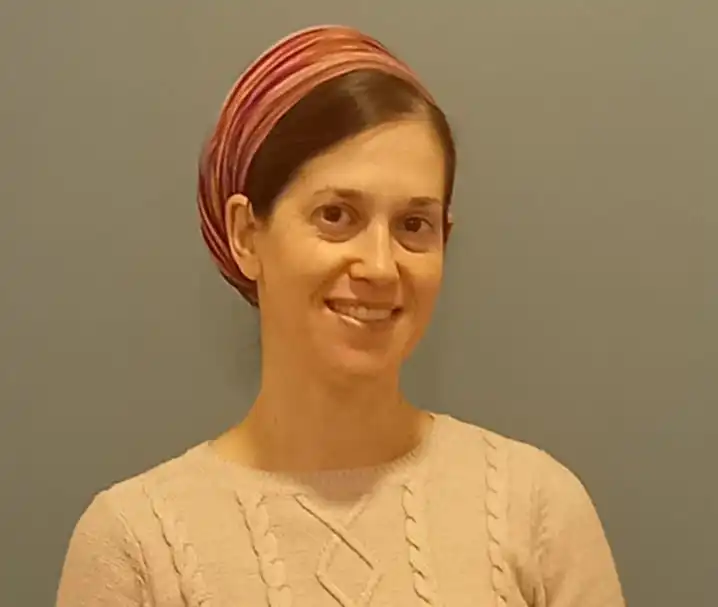מסכת זבחים
מסכת זבחים מוקדש ע”י אסתר קרמר לע”נ אביה מני גרוס.
הלימוד השבוע מוקדש ע”י רוברט ופאולה כהן לע”נ יוסף בן משה הכהן ז”ל. יוסף היה חזן שאהב מאוד לשיר, עבד קשה בחייו והיה מאוד מסור למשפחתו ולקהילה.
רוצה להקדיש שיעור?

תקציר
רבי יהודה הנשיא (רבי) מפרש את האזכור הראשון של "פר” בויקרא ד:כ כמתייחס לפר של יום הכיפורים, אף על פי שההקשר של הפסוק עוסק בפר העלם דבר של ציבור. לדעת רבי, פסוק זה בא ללמד שפר יום הכיפורים דומה לפר החטאת של כהן גדול שחטא, המוזכר באזכור השני של "פר” באותו פסוק.
רבי ישמעאל חולק על רבי, וטוען שניתן ללמוד את דיני פר יום הכיפורים באמצעות קל וחומר. הקל וחומר שהוא מציע אינה ברורה לגמרי, והגמרא מבארת לאילו מקרים הוא מתייחס בדבריו ומהם הדינים הנלמדים.
מכיוון שרבי ישמעאל אינו מפרש את המילה "פר” כמתייחסת לפר של יום הכיפורים, אלא לפר העלם דבר של הציבור, עולה השאלה: מדוע להשתמש במילה "פר” ולא לומר פשוט "אותו”? רב פפא מסביר שהמילה המיותרת באה ללמד דין שאינו כתוב במפורש בפסוקים על פר העלם דבר של ציבור, אך מופיע בקרבן החטאת של כהן גדול – שיותרת הכבד והכליות נשרפים על המזבח. אף שניתן היה ללמוד דין זה בהיקש, הוספת המילה "פר”עושה את הדין לכאילו נכתב במפורש, וכך ניתן להשתמש בו כדי ללמוד את אותו דין בהיקש לקרבן החטאת של הציבור שחטאו בעבודה זרה.
ברייתא מובאת לתמוך בהסברו של רב פפא, ומראה כיצד נוצר ההיקש בין פר העלם דבר של ציבור לבין קרבן החטאת של הציבור בעבודה זרה (במדבר טו:כה). עם זאת, ברייתא נוספת לומדת את ההיקש מהפסוק בויקרא ד:כ. שני ההיקשים נחשבים לנחוצים, שכן כל אחד מהם מלמד דין אחר.
עמדתו של רבי מובאת קודם לכן כדי לתמוך בהסברו של רב פפא, שהמילה "פר” באה להשוות את פר יום הכיפורים לפר החטאת של כהן גדול לגבי דינים מסוימים הנלמדים מהמילים "את”, "בדם” ו”טבל”. אך רבי עצמו אומר שההשוואה באה ללמד שכל הדינים שווים, ולא רק שלושת אלה. הבדל זה מוסבר כמתבסס על שתי עמדות תנאיות שונות.
שתי ברייתות מבית מדרשו של רבי ישמעאל מובאות, וכל אחת מהן מסבירה מדוע מילים או דינים מסוימים מופיעים רק בקרבן החטאת של כהן גדול ולא בפר העלם דבר של ציבור. שתיהן מוסברות באמצעות משלים המתארים את מערכת היחסים בין הקב”ה לעמו.
לבסוף, משנה במסכת מנחות מביאה מחלוקת בין רבי מאיר לחכמים לגבי האם מחשבת פיגול בעת לקיחת הקומץ ממנחת הסולת, אך לא בעת לקיחת הקומץ מהלבונה (או להפך), הופכת את הקרבן לפיגול. ריש לקיש מסביר את עמדתו של רבי מאיר: הקרבן הופך לפיגול לא משום שמחשבה פיגול תקפה אפילו כשישנו מחשבה הפוסלת רק בחלק מהמתיר (מפגלים בחצי מתיר), אלא משום שהמעשה השני נחשב כמתבצע לפי הכוונה הראשונית. כלומר, אם הייתה כוונה פסולה בשלב הראשון, והשלב השני נעשה ללא כוונה, הרי שהשלב השני נחשב כנעשה לפי הכוונה הראשונה. ריש לקיש תומך בהבנה זו בכך שהוא טוען שהמשנה שלנו יכולה להתאים רק לדעת רבי מאיר. אך רבי שמואל בר יצחק דוחה את ההבנה הזו ומסביר את המשנה שלנו לפי דעת חכמים.
כלים
מסכת זבחים
מסכת זבחים מוקדש ע”י אסתר קרמר לע”נ אביה מני גרוס.
הלימוד השבוע מוקדש ע”י רוברט ופאולה כהן לע”נ יוסף בן משה הכהן ז”ל. יוסף היה חזן שאהב מאוד לשיר, עבד קשה בחייו והיה מאוד מסור למשפחתו ולקהילה.
הדף היום מוקדש ע”י דנה הוכהאוזר לע”נ רחל בת ניסן.
כלים
העמקה
רוצה להבין מה באמת קורה מתחת לפני השטח של הסוגיה?
שיעורים, פודקאסטים והרחבות של מיטב המורות שלנו יפתחו לך עוד זוויות וכיווני חשיבה.
חדשה בלימוד הגמרא?
זה הדף הראשון שלך? איזו התרגשות עצומה! יש לנו בדיוק את התכנים והכלים שיעזרו לך לעשות את הצעדים הראשונים ללמידה בקצב וברמה שלך, כך תוכלי להרגיש בנוח גם בתוך הסוגיות המורכבות ומאתגרות.
פסיפס הלומדות שלנו
גלי את קהילת הלומדות שלנו, מגוון נשים, רקעים וסיפורים. כולן חלק מתנועה ומסע מרגש ועוצמתי.
זבחים מא
שֶׁהוּשְׁווּ מַעֲשִׂים לְמַעֲשִׂים?!
that the actions of sprinkling the blood in one offering are equated with the actions of the blood in the other offering? The blood of the goat of Yom Kippur is sprinkled even inside the Holy of Holies, which is not so concerning the blood of the bull. Nevertheless, with regard to the sprinkling in the Sanctuary, which is common to both, their actions are performed in the same manner, with the blood being sprinkled with a finger on the Curtain and on the corners of the altar.
וַאֲתָא לֵיהּ פַּר יוֹם הַכִּפּוּרִים (נָמֵי) לְאֶת בְּדָם וּטְבִילָה מִפַּר כֹּהֵן מָשִׁיחַ; וְאָתֵי לֵיהּ שְׂעִיר יוֹם הַכִּפּוּרִים מִשְּׂעִירֵי עֲבוֹדָה זָרָה – מִקַּל וָחוֹמֶר.
And by means of this a fortiori inference the case of the bull of Yom Kippur is derived from the case of the bull of an unwitting sin of the anointed priest, with regard to the halakhot summarized by the words et, in the blood, and immersion, as they are both bulls. And likewise, the case of the goat of Yom Kippur is derived from the case of the goats for an unwitting communal sin of idol worship, with regard to the halakhot of et, in the blood, and immersion, via this a fortiori inference, as they are both goats.
וְכִי דָּבָר הַלָּמֵד בְּהֶיקֵּשׁ, חוֹזֵר וּמְלַמֵּד בְּקַל וָחוֹמֶר?! אָמַר רַב פָּפָּא: קָסָבַר תָּנָא דְּבֵי רַבִּי יִשְׁמָעֵאל: דָּבָר הַלָּמֵד בְּהֶיקֵּשׁ, חוֹזֵר וּמְלַמֵּד בְּקַל וָחוֹמֶר.
The Gemara asks: How can the halakhot of the goat of Yom Kippur be derived from the goats for an unwitting communal sin of idol worship? But does a matter derived by juxtaposition, i.e., a halakha that is not written explicitly in the Torah but that is learned by means of a comparison, again teach by a fortiori inference? There is a principle that a halakha derived by juxtaposition with regard to consecrated matters cannot subsequently teach another halakha via an a fortiori inference. The halakhot alluded to by the words et, in the blood, and immersion, are not explicitly stated with regard to the goats of an unwitting communal sin of idol worship. Rather, they are derived from the comparison found in the verse: “And he shall do…as he did” (Leviticus 4:20), which alludes to the goats for an unwitting communal sin of idol worship and the bull for an unwitting sin of the anointed priest. Rav Pappa said: The school of Rabbi Yishmael maintains that a matter derived by juxtaposition does again teach by a fortiori inference, even with regard to consecrated matters.
״לַפָּר״ – זֶה פַּר הֶעְלֵם דָּבָר שֶׁל צִבּוּר. הָא בְּצִיבּוּר גּוּפֵיהּ כְּתִיב! אָמַר רַב פָּפָּא: מִשּׁוּם דְּבָעֵי אַגְמוֹרֵי פַּר הֶעְלֵם דָּבָר שֶׁל צִבּוּר בְּיוֹתֶרֶת וּשְׁתֵּי כְּלָיוֹת, לִשְׂעִירֵי עֲבוֹדָה זָרָה.
The Gemara continues to analyze the statement of Rabbi Yishmael in the baraita: “With the bull”; this is the bull for an unwitting communal sin. The Gemara asks: Why is it necessary to derive this case by way of an exposition? This verse itself is written in reference to the bull for an unwitting communal sin. Rav Pappa said: The derivation is necessary because Rabbi Yishmael wants the case of the bull for an unwitting communal sin to teach with regard to the burning on the altar of the sacrificial portions, including the diaphragm and the two kidneys, that this obligation applies also to the goats for an unwitting communal sin of idol worship, despite the fact that this requirement is not stated with regard to them.
וּפַר הֶעְלֵם דָּבָר שֶׁל צִבּוּר – בְּגוּפֵיהּ לָא כְּתִיב, בְּהֶיקֵּשָׁא אָתֵי; אִיצְטְרִיךְ ״לַפָּר״ –
Rav Pappa continues: And as the obligation to burn the diaphragm and the two kidneys on the altar is not written with regard to the bull for an unwitting communal sin itself, but rather it is derived by juxtaposition from the bull for an unwitting sin of the anointed priest, in which this requirement is explictly stated (see Leviticus 4:8–9), it was necessary to include the bull for an unwitting communal sin once again with the term “with the bull.”
לְמִיהְוֵי כְּמַאן דִּכְתִיב בֵּיהּ בְּגוּפֵיהּ, וְלָא לֶיהֱוֵי דָּבָר הַלָּמֵד בְּהֶיקֵּשׁ חוֹזֵר וּמְלַמֵּד בְּהֶיקֵּשׁ.
The Gemara elaborates: This derivation is required in order that it should be as though this halakha of burning the diaphragm and the two kidneys was written with regard to the bull for an unwitting communal sin itself. And in this manner the derivation from this case, teaching the halakha in the case of the goats for an unwitting communal sin of idol worship, should not be a matter derived by juxtaposition that again teaches by juxtaposition, as such a derivation is not done with regard to consecrated matters.
תַּנְיָא כְּוָותֵיהּ דְּרַב פָּפָּא: ״וְעָשָׂה כַּאֲשֶׁר עָשָׂה״ – מָה תַּלְמוּד לוֹמַר ״לַפָּר״?
§ The Gemara comments: It is taught in a baraita in accordance with the opinion of Rav Pappa: “And he shall do with the bull, as he did” (Leviticus 4:20); what is the meaning when the verse states: “With the bull”? It is clear that this verse is referring to the bull.
לְפִי שֶׁנֶּאֱמַר: ״וְהֵם הֵבִיאוּ אֶת קׇרְבָּנָם אִשֶּׁה לַה׳ וְגוֹ׳״; ״חַטָּאתָם״ – אֵלּוּ שְׂעִירֵי עֲבוֹדָה זָרָה, ״שִׁגְגָתָם״ – זֶה פַּר הֶעְלֵם דָּבָר שֶׁל צִבּוּר, ״חַטָּאתָם עַל שִׁגְגָתָם״ – אָמְרָה תּוֹרָה: חַטָּאתָם הֲרֵי הִיא לָךְ כְּשִׁגְגָתָם;
The baraita answers: Because it is stated with regard to the goats for an unwitting communal sin of idol worship: “And they have brought their offering, an offering made by fire to the Lord, and their sin offering before the Lord for their error” (Numbers 15:25), and this verse is interpreted as follows: “Their sin offering”; these are the goats for an unwitting communal sin of idol worship, alluded to in that passage. “Their error”; this is the bull for an unwitting communal sin, which is brought for an inadvertent transgression of the community. The juxtaposition of these offerings in the verse: “Their sin offering…for their error,” indicates that the Torah means to say: Their sin offering is for you like their error, i.e., all the portions consumed on the altar in the case of the bull for an unwitting communal sin are also burned on the altar in the case of the goats for an unwitting sin of idol worship.
שִׁגְגָתָם מֵהֵיכָן לָמַדְתָּ – לֹא בְּהֶיקֵּשׁ? וְכִי דָּבָר הַלָּמֵד בְּהֶיקֵּשׁ חוֹזֵר וּמְלַמֵּד בְּהֶיקֵּשׁ?!
The Gemara asks: With regard to the offering brought for their error, i.e., the bull for an unwitting communal sin, from where did you learn this halakha? Was it not via juxtaposition from the bull for an unwitting sin of the anointed priest, as the diaphragm and the two kidneys are not explicitly mentioned with regard to the bull for an unwitting communal sin? But this is difficult, as does a matter derived via juxtaposition again teach via juxtaposition?
תַּלְמוּד לוֹמַר: ״לַפָּר״ – זֶה פַּר הֶעְלֵם דָּבָר שֶׁל צִבּוּר, ״לְפַר״ – זֶה פַּר כֹּהֵן מָשִׁיחַ.
Therefore, the verse states: “And he shall do with the bull, as he did with the bull for a sin offering” (Leviticus 4:20). With regard to the first instance of “with the bull,” this is the bull for an unwitting communal sin. And with regard to the second instance of “with the bull,” this is the bull for an unwitting sin of the anointed priest. Due to this juxtaposition, it is as though the burning of the diaphragm and the two kidneys was explicitly written with regard to the bull for an unwitting communal sin, and therefore the halakha can be taught by juxtaposition with regard to the goats for an unwitting sin of idol worship, as stated by Rav Pappa.
אָמַר מָר: ״חַטָּאתָם״ – אֵלּוּ שְׂעִירֵי עֲבוֹדָה זָרָה. תִּיפּוֹק לֵיהּ מִקְּרָא קַמָּא, דְּאָמַר מָר: ״הַחַטָּאת״ – לְרַבּוֹת שְׂעִירֵי עֲבוֹדָה זָרָה! אָמַר רַב פָּפָּא: אִיצְטְרִיךְ; סָלְקָא דַּעְתָּךְ אָמֵינָא: הָנֵי מִילֵּי הַזָּאוֹת – דִּכְתִיבָן בְּגוּפֵיהּ,
The Gemara analyzes the previous baraita. The Master said above: “Their sin offering,” these are the goats for an unwitting communal sin of idol worship, which are juxtaposed in this verse to the bull for an unwitting communal sin. The Gemara asks: But let the tanna derive this from the earlier verse stated with regard to the bull for an unwitting communal sin, as the Master said in the baraita cited earlier (39b): “A sin offering” (Leviticus 4:20), this serves to include the goats for an unwitting communal sin of idol worship. Rav Pappa said: This derivation was necessary, as if there were only the juxtaposition from Leviticus 4:20, it would enter your mind to say: This matter applies only to the acts of sprinkling, which are written with regard to the bull for an unwitting communal sin itself.
אֲבָל יוֹתֶרֶת וּשְׁתֵּי כְלָיוֹת – דְּלָא כְּתִיבָן בְּגוּפֵיהּ, אֵימָא לָא; קָא מַשְׁמַע לַן.
But with regard to the burning of the diaphragm and the two kidneys, which are not written with regard to the bull for an unwitting communal sin itself, you might say that this halakha should not be derived from it. Therefore, this additional derivation of “their sin offering” teaches us that the two offerings are similar with regard to this detail as well.
אֲמַר לֵיהּ רַב הוּנָא בְּרֵיהּ דְּרַב נָתָן לְרַב פָּפָּא: וְהָא תַּנָּא – פַּר יוֹם הַכִּפּוּרִים לְכׇל מַה שֶּׁאָמַר בְּעִנְיָן קָאָמַר! תַּנָּאֵי הִיא; תַּנָּא דְּבֵי רַב מְרַבֵּי הָכִי, תַּנָּא דְּבֵי רַבִּי יִשְׁמָעֵאל לָא מְרַבֵּי הָכִי.
Rav Huna, son of Rav Natan, said to Rav Pappa: But the tanna said: “With the bull”; this serves to include the bull of Yom Kippur for all that is stated in this matter. This statement indicates that all the details applying to the bull for an unwitting communal sin are extended to the bull of Yom Kippur by means of a single derivation. Rav Pappa responded: This issue is a dispute between tanna’im, as the tanna of the school of Rav amplifies the halakha through this juxtaposition, whereas the tanna of the school of Rabbi Yishmael does not amplify the halakha through this juxtaposition, but maintains that an additional derivation is necessary with regard to the diaphragm and the two kidneys.
תָּנָא דְּבֵי רַבִּי יִשְׁמָעֵאל: מִפְּנֵי מָה נֶאֶמְרוּ יוֹתֶרֶת וּשְׁתֵּי כְלָיוֹת בְּפַר כֹּהֵן מָשִׁיחַ, וְלֹא נֶאֶמְרוּ בְּפַר הֶעְלֵם דָּבָר שֶׁל צִבּוּר? מָשָׁל לְמֶלֶךְ בָּשָׂר וָדָם שֶׁזָּעַם עַל אוֹהֲבוֹ, וּמִיעֵט בְּסִרְחוֹנוֹ מִפְּנֵי חִיבָּתוֹ.
§ The Gemara cites a statement that is related to the above halakhot. The school of Rabbi Yishmael taught: For what reason are the diaphragm and the two kidneys stated with regard to the bull for an unwitting sin of the anointed priest, and they are not explicitly stated with regard to the bull for an unwitting communal sin? This can be explained by a parable: It can be compared to a flesh-and-blood king who grew angry with his beloved servant for his misdeeds, but spoke little of the servant’s offense due to his great affection for him. Likewise, as the Jewish people are beloved by God, the Torah does not describe their sin offering in detail.
וְתָנָא דְּבֵי רַבִּי יִשְׁמָעֵאל: מִפְּנֵי מָה נֶאֶמְרָה ״פָּרֹכֶת הַקֹּדֶשׁ״ בְּפַר כֹּהֵן מָשִׁיחַ, וְלֹא נֶאֱמַר בְּפַר הֶעְלֵם דָּבָר שֶׁל צִבּוּר? מָשָׁל לְמֶלֶךְ בָּשָׂר וָדָם שֶׁסָּרְחָה עָלָיו מְדִינָה; אִם מִיעוּטָהּ סָרְחָה – פָּמַלְיָא שֶׁלּוֹ מִתְקַיֶּימֶת, אִם רוּבָּהּ סָרְחָה – אֵין פָּמַלְיָא שֶׁלּוֹ מִתְקַיֶּימֶת.
And the school of Rabbi Yishmael further taught: For what reason is it stated: “Before the Curtain of the Sanctuary” (Leviticus 4:6), with regard to the bull for an unwitting sin of the anointed priest, and this is not stated with regard to the bull for an unwitting communal sin, where it merely states: “Before the Curtain” (Leviticus 4:17)? This can be explained by a parable: It can be compared to a flesh-and-blood king against whom a province sinned. If a minority of that province sinned, his relationship with his entourage [pamalya] remains, i.e., the king continues to treat his loyal followers in the usual manner. But if the majority of the province sinned, his relationship with his entourage does not remain, and he no longer meets even those who remained devoted to him. Similarly, when the entire people sins, God no longer has the same relationship with them, and it is as though the place where the priest sprinkles the blood is no longer sacred.
לְפִיכָךְ אִם נָתַן כּוּלָּן כְּתִיקְנָן כּוּ׳. תְּנַן הָתָם: פִּיגֵּל בַּקּוֹמֶץ וְלֹא בַּלְּבוֹנָה; בַּלְּבוֹנָה וְלֹא בַּקּוֹמֶץ – רַבִּי מֵאִיר אוֹמֵר: פִּיגּוּל, וְחַיָּיבִין עָלָיו כָּרֵת.
§ The mishna teaches that all the placements upon the inner altar are indispensable, and therefore if the High Priest placed all the placements in their proper manner, and one in an improper manner, i.e., with the intent to eat or burn the offering beyond its designated time, the offering is disqualified, but there is no liability for karet for one who partakes of the offering. The Gemara states that we learned in a mishna there (Menaḥot 16a), with regard to the burning of the handful of a meal offering and the frankincense, both of which render the meal offering permitted for eating: If the priest had an intention that can render the offering piggul, and this occurred during the burning of the handful but not during the burning of the frankincense, or during the burning of the frankincense but not during the burning of the handful, i.e., he burned one of them with the intention of eating the remainder of the offering beyond its designated time, Rabbi Meir says: The offering is piggul and one who eats it is liable to receive karet.
וַחֲכָמִים אוֹמְרִים: אֵין בּוֹ כָּרֵת עַד שֶׁיְּפַגֵּל בְּכׇל הַמַּתִּיר.
And the Rabbis say: There is no liability for karet in this case unless he renders the offering piggul during the performance of the entire permitting factor, i.e., the burning of both the handful and the frankincense.
אָמַר רַבִּי שִׁמְעוֹן בֶּן לָקִישׁ: לָא תֵּימָא טַעְמָא דְּרַבִּי מֵאִיר, דְּקָסָבַר מְפַגְּלִין בַּחֲצִי מַתִּיר; אֶלָּא הָכָא בְּמַאי עָסְקִינַן – כְּגוֹן שֶׁנָּתַן אֶת הַקּוֹמֶץ בְּמַחְשָׁבָה, וְהַלְּבוֹנָה בִּשְׁתִיקָה; קָסָבַר: כׇּל הָעוֹשֶׂה – עַל דַּעַת רִאשׁוֹנָה הוּא עוֹשֶׂה.
Rabbi Shimon ben Lakish said: Do not say that the reason of Rabbi Meir, who holds that the offering is piggul, is that he holds in general that one renders an offering piggul even if he intended to eat or burn the offering beyond its designated time during the performance of only half a permitting factor. Rather, what are we dealing with here? We are dealing with a case where he initially placed the handful of the meal offering on the altar, to burn it, with the improper intention to eat the remainder beyond its designated time, and afterward he placed the frankincense on the altar silently, i.e., without any particular intent. Rabbi Meir holds: Anyone who performs an action performs it with his initial intent. Therefore, his action with the frankincense is considered to have been performed with the same improper intention as his action with the handful.
מִמַּאי? מִדְּקָתָנֵי: לְפִיכָךְ אִם נָתַן כּוּלָּן כְּתִיקְנָן וְאַחַת שֶׁלֹּא כְּתִיקְנָהּ – פָּסוּל וְאֵין בּוֹ כָּרֵת. הָא אַחַת שֶׁלֹּא כְּתִיקְנָהּ וְכוּלָּן כְּתִיקְנָן – פִּיגּוּל;
The Gemara asks: From where does Rabbi Shimon ben Lakish learn that this is the case? He learns it from the fact that the mishna teaches: Therefore, if he placed all the placements in their proper manner and one in an improper manner, the offering is disqualified, but there is no liability for karet. Consequently it follows that if he initially placed one placement in an improper manner, with the intent to eat or burn the offering beyond its designated time, and all the other placements in the proper manner, the offering is piggul.
מַנִּי? אִילֵּימָא רַבָּנַן – הָא אָמְרִי רַבָּנַן: אֵין מְפַגְּלִין בַּחֲצִי מַתִּיר! אֶלָּא רַבִּי מֵאִיר.
The Gemara explains: Whose opinion is this? If we say it is the opinion of the Rabbis, don’t the Rabbis explicitly say that one cannot render an offering piggul with an improper intention in the performance of only half a permitting factor? Here, the priest placed one placement in the proper manner. Rather, it must represent the opinion of Rabbi Meir, who says that if he had an improper intention with regard to the handful and not the frankincense the offering is piggul.
וְאִי טַעְמָא דְּרַבִּי מֵאִיר מִשּׁוּם דִּמְפַגְּלִין בַּחֲצִי מַתִּיר הוּא – אֲפִילּוּ כִּדְקָתָנֵי נָמֵי! לָאו מִשּׁוּם דְּקָסָבַר: כׇּל הָעוֹשֶׂה – עַל דַּעַת רִאשׁוֹנָה הוּא עוֹשֶׂה?
And if Rabbi Meir’s reason is that he holds in general that one renders an offering piggul even during the performance of only half a permitting factor, even if the priest acted as it taught in the mishna, the offering should also be piggul, as he had an improper intention during half the permitting factor. Rather, is Rabbi Meir’s reason not because he holds that anyone who performs an action performs it with his initial intent? Consequently, if he placed the first placement with an improper intention, the offering is piggul, and if his intention during the first placement was proper, the offering is not piggul.
אָמַר רַבִּי שְׁמוּאֵל בַּר יִצְחָק: לְעוֹלָם רַבָּנַן הִיא; וּמַאי כְּתִיקְנָן – כְּתִיקְנָן לְפִיגּוּל.
Rabbi Shmuel bar Yitzḥak says: Actually, it is possible that the mishna is in accordance with the opinion of the Rabbis, who maintain that one cannot render an offering piggul with an improper intention during half a permitting factor. And what is the meaning of the term: In their proper manner, in the context of the mishna? It means in their proper manner with regard to piggul, i.e., he placed the blood with an intention that renders the offering piggul. The mishna is teaching that although he placed the first placements with an improper intention, one does not say that the last placement, which was placed without any specific intention, was performed with his initial intent.
וְהָא מִדְּקָתָנֵי: לְפִיכָךְ אִם נָתַן כּוּלָּן כְּתִיקְנָן וְאַחַת שֶׁלֹּא כְּתִיקְנָן – פָּסוּל וְאֵין בּוֹ כָּרֵת; מִכְּלָל דְּתִיקְנָהּ – לְהֶכְשֵׁירָה הוּא דַּאֲתָא!
The Gemara raises a difficulty: But from the fact that it teaches: Therefore, if he placed all the placements in their proper manner and one in an improper manner, the offering is disqualified but there is no liability for karet, which indicates that the offering is disqualified due to the one placement performed improperly, one can learn by inference that the term: In their proper manner, comes to indicate an intention that renders the offering fit, and not an intention that renders it piggul.
אָמַר רָבָא: מַאי שֶׁלֹּא כְּתִיקְנָהּ – חוּץ לִמְקוֹמוֹ. רַב אָשֵׁי אָמַר: שֶׁלֹּא לִשְׁמוֹ.
Rava says: It can still be explained that the term: In their proper manner, is referring to an intention that renders the offering piggul; and what is the meaning of: In an improper manner? This is referring to the intent to eat the offering outside its designated area. This intention serves to disqualify the offering, which means that it is not piggul, as not all its rites have been performed in the proper manner. Rav Ashi says: The term: In an improper manner, in the mishna, means that he placed one placement not for the sake of the offering being sacrificed, and in the case of a sin offering an intention of this kind disqualifies the offering; therefore, it is not piggul.
מִכְּלָל דְּכִי לָא עָבֵיד לַהּ חוּץ לִמְקוֹמוֹ וְשֶׁלֹּא לִשְׁמוֹ – מִחַיַּיב!
The Gemara raises a difficulty: If so, one can learn by inference that when the priest does not perform the last placement with the intent to eat the offering outside its designated area or not for the sake of the offering, but silently, he becomes liable, as the offering is piggul. This is certainly not in accordance with the opinion of the Rabbis, as they maintain that one cannot render an offering piggul with an improper intention during half a permitting factor.
אַיְּידֵי דִּתְנָא רֵישָׁא פִּיגּוּל וְחַיָּיבִין עָלָיו כָּרֵת, תְּנָא נָמֵי סֵיפָא פָּסוּל וְאֵין בּוֹ כָּרֵת.
The Gemara answers: The wording of the mishna is imprecise, as in fact, even if he placed the last placement silently the offering is not piggul. But since the tanna of the mishna taught in the first clause, with regard to an offering whose blood is placed on the external altar: If he placed the first placement with the intent to eat the offering beyond its designated time and the second placement with the intent to eat it outside its designated area, the offering is piggul and one is liable to receive karet for its consumption, he likewise taught the latter clause, with regard to a sin offering whose blood is placed on the inner altar, in a similar manner, that if he placed the last placement with the intent to eat it outside its designated area or not for the sake of the offering, the offering is disqualified, but there is no liability for karet for its consumption. One cannot infer from here that if he placed the last placement without intent the offering is piggul.
מֵיתִיבִי: בַּמֶּה דְּבָרִים אֲמוּרִים – בְּדָמִים הַנִּיתָּנִין עַל מִזְבֵּחַ הַחִיצוֹן;
The Gemara raises an objection to the opinion of Rabbi Shimon ben Lakish from a baraita: In what case is this statement, that the offering is rendered piggul even when he intends to eat it beyond its designated time only in the first placement, said? In the case of blood that is placed on the external altar, where one placement renders the offering permitted.

